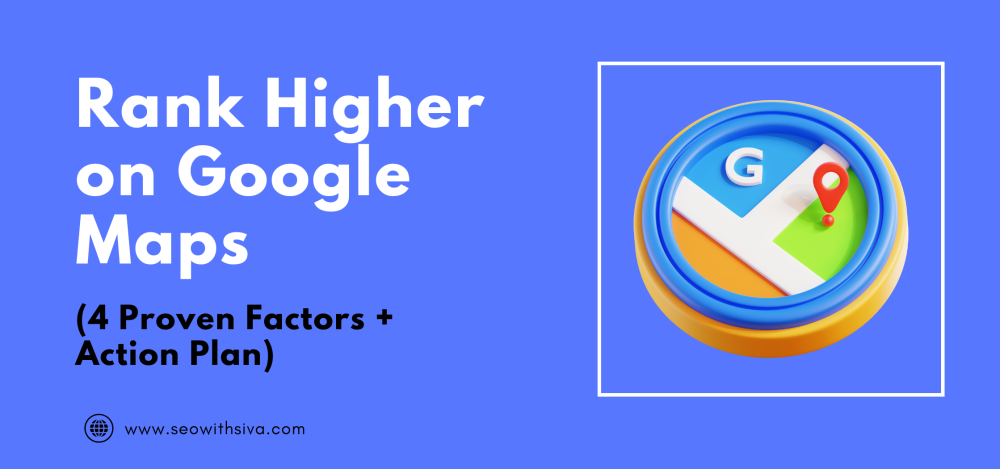
Why Google Maps Rankings Matter in 2025
Rank Higher on Google Maps is crucial for local businesses. Studies indicate that 88% of users who find a business on Google Maps contact or visit it within the same day. If your competitors are visible and you’re not, you’re potentially losing valuable leads and revenue.
Ranking higher on Google Maps isn’t about chance; it’s about understanding and leveraging key ranking factors. By focusing on these areas, you can enhance your visibility and attract more customers.
1. Optimize Your Google Business Profile (GBP)
Your GBP is the cornerstone of your local SEO efforts. Ensure it’s fully optimized by:
-
Claiming and Verifying Your Profile: This confirms your business’s legitimacy and allows you to manage your information.
-
Providing Accurate and Consistent Information: Ensure your Name, Address, and Phone number (NAP) are consistent across all platforms.
-
Selecting the Right Categories: Choose primary and secondary categories that accurately represent your business.
-
Adding High-Quality Photos: Include images of your products, services, and premises to engage potential customers.
-
Regularly Updating Your Profile: Post updates, offers, and events to keep your audience informed and engaged.
A well-optimized GBP increases your chances of appearing in local search results and builds trust with potential customers.
Here is the full tips that are cited in google offical website – Learn how to edit your Business Profile
Download our comprehensive Google Maps Success Checklist PDF to ensure your business ranks higher in 2025.
2. Leverage the Hidden Service Menu
Many businesses overlook the “Services” section in their GBP. This feature allows you to list specific services you offer, each with a 300-character description. By utilizing this, you can:
-
Target Specific Keywords: Incorporate relevant keywords to improve search visibility.
-
Enhance Relevance: Provide detailed information about your services to match user queries.
-
Improve User Experience: Help potential customers understand exactly what you offer.
Regularly updating this section with accurate and detailed information can boost your local search rankings.
3. Collect and Manage Reviews Effectively
Customer reviews are a significant ranking factor for Google Maps. To harness their full potential:
-
Encourage Reviews: Politely ask satisfied customers to leave reviews, providing them with easy access links.
-
Respond Promptly: Acknowledge all reviews, both positive and negative, to show you value customer feedback.
-
Maintain Consistency: Aim for a steady influx of reviews to signal ongoing customer satisfaction.
Studies show that businesses with recent, positive reviews are more likely to rank higher in local search results.
4. Build Local Citations and Backlinks
Local citations and backlinks from reputable sources can enhance your business’s authority and relevance. Consider:
-
Listing in Local Directories: Ensure your business is listed in reputable local directories.
-
Getting Featured in Local Media: Collaborate with local news outlets or blogs to gain exposure.
-
Partnering with Local Organizations: Engage with local chambers of commerce or community groups to build relationships and gain backlinks.
These efforts can improve your business’s prominence and trustworthiness in Google’s eyes.
Bonus Tip: Hyper-Local Landing Pages
Creating dedicated landing pages for specific services and locations can improve your local SEO. Each page should include:
-
Service and Location Keywords: Incorporate relevant keywords to target specific searches.
-
Local Landmarks and References: Mention nearby landmarks to enhance local relevance.
-
Embedded Google Map: Include a map to help users locate your business easily.
-
Schema Markup: Use structured data to help search engines understand your content better.
This strategy can increase your chances of appearing in local search results for specific queries.
Bonus Tip: Hyper-Local Landing Pages
Creating dedicated landing pages for specific services and locations can improve your local SEO. Each page should include:
-
Service and Location Keywords: Incorporate relevant keywords to target specific searches.
-
Local Landmarks and References: Mention nearby landmarks to enhance local relevance.
-
Embedded Google Map: Include a map to help users locate your business easily.
-
Schema Markup: Use structured data to help search engines understand your content better.
This strategy can increase your chances of appearing in local search results for specific queries.
Conclusion
Ranking higher on Google Maps in 2025 requires a strategic approach focusing on trust, relevance, and consistency. By optimizing your Google Business Profile, managing reviews effectively, building local citations, and creating hyper-local content, you can improve your visibility and attract more customers. Start implementing these strategies today to see tangible results in the coming weeks.
Here is the checklist attachment –
Google Maps Ranking Factors Checklist – SEOwithSiva.com – Sheet2
Reference Links:
